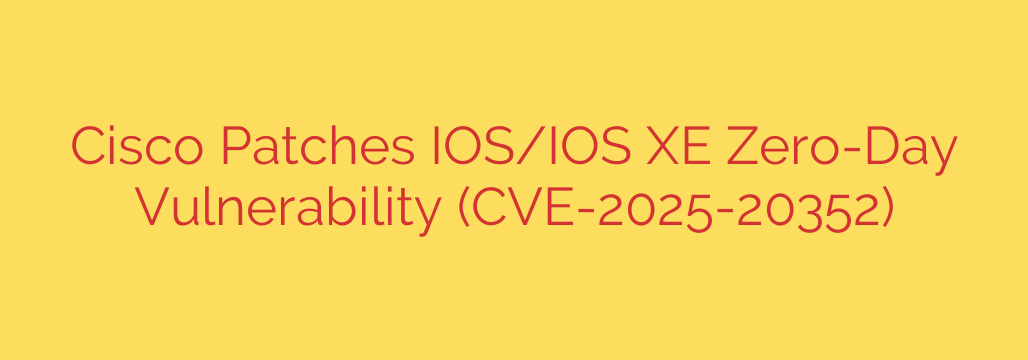
Urgent Security Alert: Cisco Patches Critical Zero-Day Flaw in IOS and IOS XE Software (CVE-2025-20352)
Network administrators and security professionals must take immediate action following the discovery of a critical zero-day vulnerability in Cisco IOS and IOS XE software. Tracked as CVE-2025-20352, this high-severity flaw could allow an unauthenticated, remote attacker to cause unexpected device reloads, leading to a crippling denial of service (DoS) condition.
Cisco has released crucial software updates to address this vulnerability, which was reportedly being exploited in the wild before a patch was available. Given the active exploitation and the widespread use of the affected software, patching systems should be considered a top priority for all organizations running vulnerable versions.
Understanding the Threat: What is CVE-2025-20352?
The core of this vulnerability lies in how Cisco’s software processes specific types of network traffic. An attacker can exploit this flaw by sending a specially crafted packet to a vulnerable device. Successful exploitation does not require any user authentication, making it a particularly dangerous threat that can be launched from anywhere on the internet.
The primary impact of this attack is a Denial of Service (DoS). When the device attempts to process the malicious packet, a critical error occurs, forcing the system to reload. Repeated attacks could keep a device in a continuous reboot loop, effectively taking it offline and causing significant network disruption.
Key details about the vulnerability include:
- Remote & Unauthenticated: Attackers do not need credentials or local network access to exploit the flaw.
- High-Severity Impact: A successful attack can crash essential network infrastructure like routers and switches.
- Affects Core Network Software: The vulnerability impacts both Cisco IOS and IOS XE, two of the most widely deployed network operating systems in the world.
While the immediate confirmed threat is a DoS attack, vulnerabilities of this nature can sometimes lead to more severe consequences, such as arbitrary code execution. At this time, the focus remains on preventing device crashes and network outages.
Is Your Network at Risk? Affected Systems and Conditions
This vulnerability affects a wide range of Cisco devices running vulnerable versions of IOS and IOS XE Software. According to the security advisory, a device is only vulnerable if it has a specific service or feature enabled and exposed to the attacker.
To determine if your systems are vulnerable, you must check your specific software version against the official Cisco security advisory. Administrators should not assume their configuration is safe and must perform a thorough audit of all running Cisco IOS and IOS XE devices.
How to Protect Your Network: Immediate Steps to Take
There are no effective workarounds that can reliably mitigate this vulnerability. Therefore, the only permanent solution is to update your software to a fixed version.
1. Identify Vulnerable Devices:
Begin by inventorying all Cisco devices running IOS and IOS XE software. Use Cisco’s tools and your network management systems to identify the exact software versions currently deployed across your infrastructure.
2. Apply Official Patches Immediately:
Updating your software is the most critical step. Cisco has released fixed versions of IOS and IOS XE to address CVE-2025-20352. You can download the appropriate updates from the official Cisco Software Center. Prioritize patching internet-facing and other mission-critical devices first to reduce your exposure as quickly as possible.
3. Implement Access Control as a Temporary Measure:
If you are unable to patch immediately, you can reduce the risk of exploitation by implementing strict access control lists (ACLs). By creating ACLs, you can limit access to the affected services from untrusted IP addresses and networks. This is not a substitute for patching, but it can provide a temporary layer of defense by minimizing the attack surface.
4. Monitor Network Traffic:
Keep a close watch on your network logs and traffic for any signs of unusual activity or unexpected device reboots. Proactive monitoring can help you detect potential exploitation attempts and respond quickly to any incidents.
In today’s threat landscape, zero-day vulnerabilities in core network infrastructure represent a severe risk. Proactive and swift patching is essential to maintaining network stability, security, and availability. All organizations using Cisco IOS and IOS XE devices are strongly urged to review their systems and apply the necessary updates without delay.
Source: https://www.helpnetsecurity.com/2025/09/25/cisco-ios-xe-cve-2025-20352/








